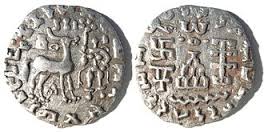
The Kuninda warrior clan is mentioned in ancient texts under the different forms of its name: Kauninda, Kulinda, and Kaulinda. Their coins have been found mostly in the Himalayan foothills, between the Rivers Sutlej and Yamuna. The Kuninda were therefore neighbors of the Kuluta and Trigarta clans.
Their coins have the figure of Bhagwan Shiva holding a trident, with the legend: Bhagwatah Chatresvara-Mahatmanah, translating to Bhagwan Shiva, tutelary deity of Ahichhatra, the Kuninda capital. On the obverse the coins portray a deer, six-arched hill, and a tree-in-railing.
These coins are made of copper, silver, and bronze, and are found from the 1st century BCE to the 3rd century CE. This suggests that the Kuninda gained independence from both the Indo-Greek and Kushan invaders. A Raja named Amoghabhuti features prominently in the later coins, which bear a striking resemblance to the coinage of the Yaudheya clan. It seems that the Kunindas in alliance with the latter ejected the Kushans in the 3rd century CE.
By the 5th century the clan-state of the Kuninda disappeared, or more accurately, broke-up into tiny fragments under the families of Ranas and Thakkuras just as their neighbors the Kuluta. The region of Simla Hills, down to the 20th century, was littered with tiny entities ruled by such petty chieftains, which were grouped by the British Empire into the Simla Hill States.
Yaudheya
Yaudheya were the rulers of South-Eastern Punjab and Rajasthan. Like many other tribes they declared their independence after the death of Pushyamitra Sunga in the middle of the second century B.C.E. Yaudheya clan has also been mentioned in Ashtadhyayi of Panini as well as in Ganapatha. They have also been referred in Mahabharata, Brihatsamhita Puranas, Chandravyakarana and Kashika. From about 200 BCE to 400 CE they were at the peak of their power. The existence of this powerful clan has come to light from their coins and coin-moulds found in large number in Sutlej, Multan, Bhatner, Sirsa, Hansi and Panipat. Most of these coins depicted the god Karttikeya or also known as Brahmanyadeva.
Yaudheya as we know it were an ancient republican city state or tribe of traders and warriors. The name ‘Yudha’ itself means a proficient fighter. Yaudheyas claim that they descended from Yudhishthira. Many ancient texts have mentioned this tribe; also historians of Alexander wrote about people ‘living in exceedingly fertile territory and good at agriculture and brave in war’. Ancient accounts of Kautilya mention many ganas(republic states) living by the profession of trades and arms and after the death of Pusyamitra Sunga started moving south wards, probably under the pressure of Indo-Greeks and occupied the region of North of Saraswati. Yaudheya had a high social and political status; thus surviving the longest reign. Yaudheya’s were probably at the height of their power and glory during the period extending from circa mid-second century BCE to the fouth century CE when they struck coins as well.
Coinage
Though coins are small in size they open up window various aspects of culture, political life, economic progress, trade and commerce of people. Especially the coins of ancient cultures where there are barely any other evidences available. The movement of various tribes can be traced from its coin. The Yaudheya issued their earliest coinage in copper, bronze and potin with the brahmi legend ‘Yoaudheyanam’. Karttikeya being the warrior god was the main deity on coins of Yaudheya and also peacock is widely depicted (vehicle of the war-god karttikeya).
- Allan extensively studies coins from Indian subcontinent and has segregated the Yaudheya coinage in 6 broad categories.
- Obverse containing combination of some of the symbols – Ujjain symbol, double trident, star or sun, triangle headed staff and legend in Brahmi ‘Maharajasa’ and inverted trident on the reverse. These coins are only found in Potin.
- Bull before sacrificial post on obverse with Brahmi legend ‘Yaudheyanam Bahudhanaka’ with elephant with a nandipada above and a flowing pennon behind.
- Coins with legend Bhanuvarmasa found along with coins of class 6.
- Represened by a single small square copper coin with the legend ‘Yaudheyanam’ above a bull to right in characters of the first century with plain or illegible reverse.
- Showing Unicephalous Karttikeya with legend ‘Yaudheya-ganasya jaya’ on the obverse and his spouse Devasena on the reverse. There are varieties with the legend followed by dviand tri and some additional symbols on the reverse.
- The obverse of the coin shows six-headed Karttikeya with brahmi legend ‘Bhagavata-svamino Brahmanya’ and reverse contains six-headed Shashthi standing facing between multi-arched chaitya surmounted by a nandipada on left with multi-branched tree in railing on right and wavy line below. This coinage is closely connected with the coinage of the Kuninda tribe. Varieties of this coinage show Siva replacing Karttikeya and deer below temple.
- UKPCS Mains Tests and Notes Program
- UKPCS Prelims Exam 2024- Test Series and Notes Program
- UKPCS Prelims and Mains Tests Series and Notes Program
- UKPCS Detailed Complete Prelims Notes
